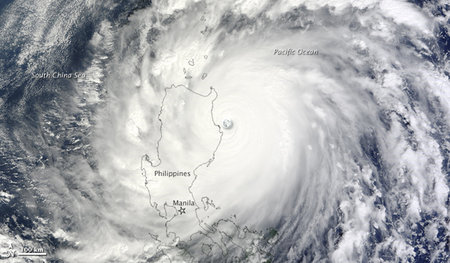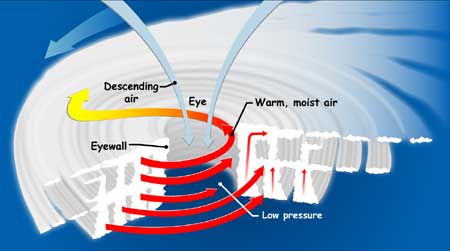
We generally relate strong winds, rain and thunder with storms. But storms have many types namely, cyclones, typhoons, hurricanes, earthquakes, tornadoes and so on. They are all the same phenomenon. They are called differently due to their location in different ocean basins. The storms that extend to about 300 miles to the north or south of the equator are Tropical Cyclones. Typhoons occur in the northwest part of the Pacific Ocean. Since it lies in the tropical region, it is sometimes referred to as tropical cyclone. Typhoons may lead to a lot of physical damage to an area. In the Atlantic or Eastern Pacific, they are called Hurricanes, and in the South Pacific and Indian Ocean, they are called Typhoons. Let us understand Typhoons in detail.
According to meteorology, Typhoons are tropical cyclones that have winds of at least 120 km/h which are sustained to its maximum. They are large storms and sometimes intensely violent. Hence, Typhoons originate in the tropics and are formed from the tropical depressions. They usually weaken as they move towards the north because the decreasing temperature results in lack of vapour of the energy loss that is caused by friction. Unlike the tropical cyclones, Typhoons do not have official seasons. In order to form and develop Typhoons, there are six main requirements, namely, sufficient warm sea-surface temperatures, atmospheric instability, high humidity, enough coriolis force, a pre-existing low-level focus and low vertical wind shear.

The air in the tropical regions is heated and goes upward. When it goes up, a large whirl is created. This circular motion may be several miles in diameter and continues due to the water vapour and the energy supplied by the heat. They travel with the general atmospheric currents and cover great distances. As they move, they gradually become larger, that is, about 10 to 15 miles. However, the winds at the centre are very strong speeding up to 150 miles per hour. As the Typhoon travels on land, it is accompanied by a storm surge which is destructive and violent. The eye of the storm, which is a calm part in the middle of the storm winds and clouds around the Typhoon.

The size of a typhoon is very large in radius. It is about 200 to 300 km in radius. From a high altitude, it appears as a round, spiral-shaped whirling cloud. The Typhoon centre is surrounded by the winds that flow in the Northern Hemisphere in a clockwise direction. Its altitude from the top to the ground is about 18000 metres and varies accordingly. Most of the time, its eye is cloudless and windless. The areas nearest to the eye have the thickest clouds and heaviest rains. Generally, Typhoons last only for one to two days and if they extend, it is about two weeks maximum.
Typhoons are classified according to the maximum speed of the wind:
-
Tropical Depression: It is the maximum wind speed at the centre which is equal to or less than 17.1 m/s which is up to 33 knots.
-
Tropical Storm: Wind speed at the centre reaches to about 17.2m/s to 32.6 m/s which is about 34 to 63 knots.
-
Typhoon: When the maximum speed of the wind reaches to about 64 to 99 knots, that is, 32.7 m/s to 50.9 m/s, it is a Typhoon.
-
Severe Typhoon: When the maximum wind speed at the centre exceeds about 100 knots or about 51.0 m/s, it is a severe Typhoon.
Various warnings are issued in the typhoon-prone areas in order to prevent the damage that is caused by the Typhoons:
-
Typhoon sea warning: When the radius of the winds are 34 knots or greater, a sea warning is issued to the anticipated areas of Taiwan, Penghu, Kinmen and Matsu. If need persists, additional warnings are announced.
-
Typhoon land warning: If the radius of the sustained winds of 34 knots or greater is about to hit the land, a land warning is issued in 18 hours and is again renewed in every 3 hours.
-
Termination of a Typhoon warning: When the sustained winds of 34 knots or greater leave the land, a Typhoon land warning gets terminated. Also, the warnings can be terminated when the Typhoon dissipates or changes its direction.
When the size, speed or the direction of the Typhoon has a change, a sea or land warning, regardless the schedule is released.
Typhoons may cause the following damage:
-
Strong Wind: It may cause the buildings to collapse, destroy telecommunications or electric circuits and also may cause damage to high stem crops and blow away the grains.
-
Foehn: It withers the crops.
-
Salty Wind: Saline wind of the sea blows to the land and withers crops and also causes other damage like the electric leakage.
-
Waves: It is because of the strong winds that there are huge waves. Some waves are about 10 to 20 metres in height and may cause shipwrecks at the sea.
-
Storm surge: The sea levels tilt due to the strong winds and apparently the low atmospheric pressure raises the sea level and enables backward flow of water towards the land.
-
Torrential rain: They destroy the crops and floods in the low-lying regions.
-
Debris flows: Soil and rocks collapse due to the torrential rains and this often lead the river to swell, causing collapsed riverbanks. Also, mud and rocks get accumulated downstream that buries the roads, buildings and farmlands.
-
Epidemic diseases: After the floods, epidemic diseases such as dysentery and cholera often spread.


